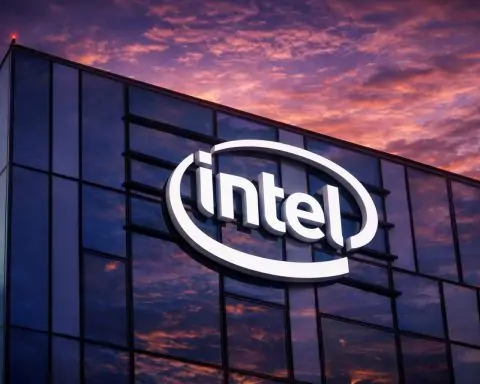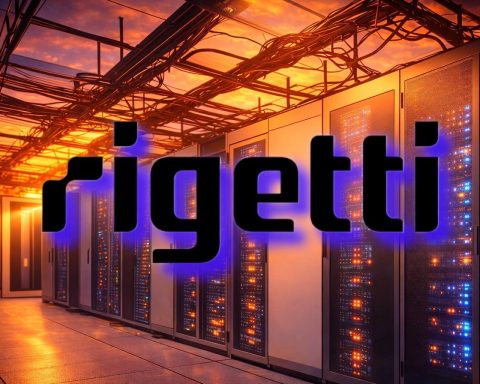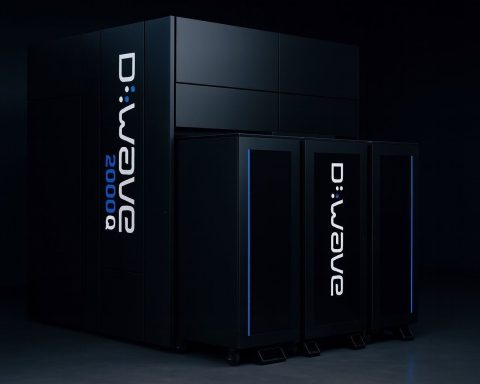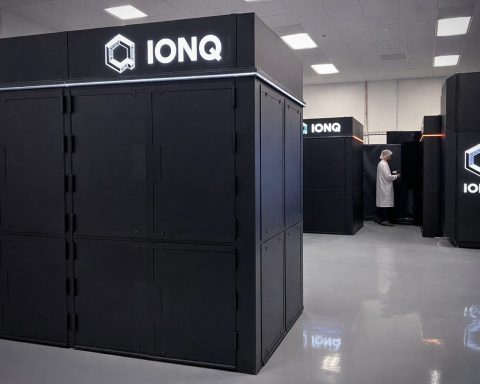- Fujitsu announced it has begun developing a superconducting quantum computer with over 10,000 physical qubits, aiming for completion in fiscal 2030, and a STAR fault-tolerant architecture to reach 250 logical qubits by 2030 and 1,000 by 2035.
- IonQ and Oak Ridge National Laboratory demonstrated a hybrid quantum-classical approach to a Unit Commitment power-grid optimization using IonQ’s 36-qubit Forte system in the DOE GRID-Q program.
- Rigetti Computing announced 99.5% two-qubit gate fidelity on its 36-qubit modular processor built from four 9-qubit chiplets, with a launch on August 15 and a plan to exceed 100 qubits by year-end 2025.
- Quantinuum opened a new R&D hub in Albuquerque, New Mexico, focusing on photonic control hardware for its trapped-ion systems, with at least seven staff to be hired by year-end.
- SEEQ moved to a 13,635 square foot U.S. headquarters in Hawthorne, New York to design, test, and manufacture quantum-ready superconductors, backed by over $60 million in funding alongside IBM Quantum and NVIDIA.
- Patero and Eridan integrated CryptoQoR post-quantum cryptography into Open RAN 5G radios to create a private quantum-secure 5G network, delivering up to 4x more data and 5x energy efficiency while aligning with U.S. federal mandates.
- A Cambridge–Paris-Saclay collaboration unveiled a carbon-based molecular material that directly couples an electron spin to emitted light, enabling optical readout of spin states via color changes between orange (triplet) and near-infrared (singlet).
- French researchers at C12 Quantum Electronics and École Normale Supérieure reported a record coherence time of ~1.3 microseconds for an electron-spin qubit in a carbon-12 nanotube double quantum dot at 0.3 K, integrated with a microwave cavity and no substrate.
- The U.S. Senate introduced the National Quantum Cybersecurity Migration Strategy Act on August 1, directing OSTP to coordinate migration to post-quantum cryptography and mandating pilot quantum-resistant encryption in critical infrastructure by 2027.
- Japan announced a ¥50 billion (about $335 million) quantum technology package led by METI to back 10+ firms across hardware, software, and a homegrown quantum OS, with 2025 dubbed the first year of quantum industrialization and a Quantum Collaboration Center called G-QuAT.
Over the past 48 hours, the quantum computing world has been buzzing with major announcements and milestones. From corporate leaps and scientific breakthroughs to government initiatives and expert insights, here’s a comprehensive roundup of all the notable quantum computing news from August 3–4, 2025. Global tech companies outlined ambitious plans, researchers set new records, governments unveiled quantum programs, investors doubled down on quantum bets, and thought leaders weighed in on the hype versus reality. Below, we break down the key developments by category, with direct quotes and sources for each item.
Industry Moves
- Fujitsu’s 10,000+ Qubit Ambition: Kicking off August, Fujitsu announced it has officially begun developing a superconducting quantum computer with over 10,000 physical qubits, slated for completion in fiscal 2030 [1]. The planned system will incorporate Fujitsu’s new “STAR” fault-tolerant architecture to achieve 250 logical qubits by 2030 and 1,000 logical qubits by 2035, as part of a government-backed project to industrialize quantum tech [2] [3]. “By realizing 250 logical qubits in fiscal 2030 and 1,000 logical qubits in fiscal 2035, Fujitsu is committed to leading the path forward globally in the field of quantum computing,” said Fujitsu CTO Vivek Mahajan, underscoring the company’s roadmap that will ultimately blend superconducting qubits with diamond-spin qubits [4] [5].
- IonQ & ORNL Optimize the Power Grid: In a notable public-private demo, IonQ and Oak Ridge National Laboratory (ORNL) revealed they solved a complex power grid optimization problem using a hybrid quantum-classical approach. Running on IonQ’s 36-qubit Forte system integrated with classical computing, the team tackled a Unit Commitment task (optimally scheduling power generators) that becomes intractable on classical computers [6] [7]. “This demonstration marks a significant milestone in applying quantum computing to real-world energy challenges,” said IonQ CEO Niccolo de Masi, who noted that as IonQ’s machines scale to “thousands and millions of qubits,” they expect to solve grid problems beyond classical reach [8]. ORNL’s project lead Suman Debnath added that this case study proved feasible on today’s device and that as the hardware improves, researchers will test for true quantum advantage in grid operations [9]. The achievement, part of the U.S. Department of Energy’s multi-year GRID-Q program, positions energy grid management as an early use-case for quantum optimization [10] [11].
- Rigetti Hits 99.5% Fidelity Milestone: Quantum hardware startup Rigetti Computing announced a major performance breakthrough, achieving 99.5% two-qubit gate fidelity on its newest modular 36-qubit superconducting processor [12]. This represents a 2× reduction in error rate from Rigetti’s previous 84-qubit chip and approaches the error thresholds needed for practical error correction. The 36-qubit device is composed of four 9-qubit “chiplets” tiled together – a multi-chip architecture that paves the way for a 100+ qubit chiplet-based system by late 2025 (with the same 99.5% fidelity target) [13] [14]. “By leveraging well-known techniques from the semiconductor industry, we’ve developed proprietary technology that we believe is critical to enable scaling to higher qubit count systems,” explained Rigetti CEO Dr. Subodh Kulkarni [15]. Rigetti plans to launch the new 36-qubit system on August 15 and remains on track to deliver a >100-qubit machine with 99.5% fidelity by year’s end [16] [17]. The news was met with enthusiasm on Wall Street – Rigetti’s stock jumped almost 10%, as analysts hailed 99.5% fidelity as a potential “gold standard” for unlocking commercial quantum applications.
- Quantinuum Expands to the Southwest:Quantinuum, the world’s largest integrated quantum computing company (formed via Honeywell Quantum and Cambridge Quantum), announced plans to open a new R&D hub in Albuquerque, New Mexico [18]. The facility will be converted into a quantum optics lab focusing initially on photonic control hardware for Quantinuum’s trapped-ion systems – essentially the lasers and optical components that manipulate ion qubits [19]. At least seven staff will be hired by year’s end as the site ramps up, and the work will integrate into Quantinuum’s full-stack operations across hardware, software, and cybersecurity [20] [21]. “We’re there to develop R&D for our hardware, but we also bring with us the connections to a full-stack quantum computing company… adding to the richness of our presence in New Mexico,” said Jenni Strabley, a Quantinuum general manager, on the move to Albuquerque [22] [23]. This marks one of the first major quantum hardware outposts in New Mexico – a state positioning itself as an emerging quantum tech hub – leveraging proximity to federal labs and a local photonics talent base. It reflects a broader industry trend of quantum firms expanding into new regions as they scale up nationally.
- SEEQC’s New Superconductor HQ: Quantum startup SEEQC, Inc. has moved into an expanded U.S. headquarters to accelerate development of its superconducting quantum chips [24] [25]. The company signed a new 13,635 sq ft lease in Hawthorne, New York, outfitting the space with office and lab facilities for designing, testing, and manufacturing “quantum-ready” superconductors at scale [26] [27]. “Moving into our U.S. headquarters marks an exciting new chapter for SEEQC, giving us the space and especially the quantum design and test infrastructure we need to scale our technology and grow our team,” said CEO John Levy [28]. Backed by over $60 million in funding and collaborating with IBM Quantum and NVIDIA, SEEQC is developing digital chip technology to control and read out quantum processors, aiming to make quantum computing more practical and scalable [29]. The new HQ – located just north of New York City – positions SEEQC closer to key partners and academic talent, and underscores the company’s growth as it works toward full-stack superconducting quantum systems.
- Quantum-Safe 5G Networks (Patero & Eridan): In a cybersecurity crossover, startup Patero (post-quantum cryptography) and wireless innovator Eridan announced they have successfully integrated quantum-resistant encryption into 5G network hardware [30] [31]. Specifically, Patero’s CryptoQoR™ post-quantum cryptography suite was run on Eridan’s new Open RAN 5G radios, creating a private 5G network solution that is secure against future quantum attacks [32] [33]. This collaboration is touted as a quantum-secure Open RAN breakthrough: “This represents a leap forward in securing our nation’s critical infrastructure,” said Eridan CEO Omid Tahernia, noting that customers get up to 4× more data in the same bandwidth and 5× energy efficiency while being protected by agile quantum-resistant encryption [34] [35]. The joint solution aligns with U.S. federal mandates to strengthen critical networks with post-quantum encryption. It highlights how quantum threats to telecom are being addressed now – well before large-scale quantum computers arrive – by combining cutting-edge 5G tech with next-gen cryptography [36] [37].
Academic Breakthroughs
- Molecule Links Spin to Light: A joint team from the University of Cambridge (UK) and Université Paris-Saclay (France) unveiled a novel carbon-based molecular material that directly couples an electron’s spin state with the light it emits. In a paper published in Nature Chemistry, the researchers engineered an organic molecule containing two linked “spin radical” units (each with an unpaired electron) that can align either in the same direction (a triplet state) or opposite (a singlet state) [38] [39]. Remarkably, the molecule’s fluorescence changes color depending on the spin state: when the two electron spins align in the triplet configuration, it emits visible orange light, but in the singlet configuration (anti-aligned spins) it emits near-infrared light [40] [41]. “This allows you to very easily detect and know the quantum states of the molecule just by looking at the colour,” explained first author Rituparno Chowdhury, a Cambridge PhD student [42]. By providing a direct optical readout of a molecule’s spin state, this research demonstrates a much simpler and cheaper approach to quantum spin sensing than using exotic materials like nitrogen-vacancy diamonds [43] [44]. The discovery opens a new path toward low-cost, tunable quantum sensors and light-based quantum devices, where information encoded in electron spins can be read out by the color of light the molecule emits – all in an organic material.
- Record-Long Qubit Coherence in Carbon: French researchers at startup C12 Quantum Electronics and the École Normale Supérieure achieved a record-setting coherence time of ~1.3 microseconds for an electron-spin qubit in a carbon-based circuit [45]. This is about 100× longer than previous carbon nanotube qubits and even 10× longer than typical silicon spin qubits under similar conditions [46]. The experiment, published in Nature Communications, used a suspended carbon-12 nanotube double quantum dot integrated in a microwave cavity at 0.3 K temperature [47] [48]. By using an ultra-pure ^12C nanotube (eliminating nuclear spins that cause noise) and suspending it with no substrate, the team drastically reduced environmental decoherence [49] [50]. They also coupled the nanotube qubit to cavity photons for control instead of any external magnetic field, further suppressing noise and enabling stable quantum oscillations in the qubit for microsecond durations [51] [52]. These coherence times rival or exceed those of many silicon qubits, reviving interest in carbon nanotubes as a platform for scalable quantum processors [53] [54]. The result sets a new benchmark for hybrid spin-photon devices in a circuit QED setup, and suggests that with “clean” carbon materials (which have no intrinsic nuclear spin) plus clever engineering, carbon-based qubits could become serious contenders in the race for longer-lived, high-fidelity quantum bits [55]. Operating at a relatively higher temperature (300 mK) without sacrificing coherence, this approach hints at more easily scalable quantum hardware.
Regulatory and Policy Updates
- U.S. Pushes for Quantum-Proof Encryption: In Washington, two U.S. senators introduced the National Quantum Cybersecurity Migration Strategy Act on August 1 – a bipartisan bill to ensure federal agencies prepare for the day quantum computers can break current encryption [56] [57]. The proposed law directs the White House Office of Science and Technology Policy to develop a coordinated roadmap for migrating government systems to post-quantum cryptography and mandates pilot programs for quantum-resistant encryption in critical infrastructure by 2027 [58] [59]. “It’s critical that the federal government be prepared for any threat posed by quantum computing technology, especially when it concerns our national security,” said Senator Gary Peters, who co-sponsored the bill [60]. The effort builds on the 2018 National Quantum Initiative and 2022 Quantum Cybersecurity Preparedness Act, reflecting growing concern in DC about the looming “Q-day” when a powerful quantum machine could jeopardize classical RSA encryption. By starting the transition now – even though code-breaking quantum computers are still years away – lawmakers aim to avoid a last-minute scramble to secure sensitive data in the future [61] [62]. The bill would leverage existing experts (an interagency ESIX subcommittee) to guide the migration and require each federal agency to quantum-proof at least one high-impact IT system as a pilot [63].
- India’s $20 B Quantum Mission (Karnataka): In India, the state government of Karnataka (home to tech hub Bengaluru) launched an ambitious ₹1,000 crore (~$114 million) Karnataka Quantum Mission as a roadmap to create a $20 billion “quantum economy” by 2035 [64]. Unveiled by Chief Minister Siddaramaiah at the Quantum India 2025 summit in Bengaluru, the plan is built on five pillars: talent development (quantum curricula across 20+ colleges and 150 PhD fellowships each year), R&D excellence (developing a homegrown 1,000-qubit quantum processor around 2030 and piloting quantum tech in healthcare, security, etc.), infrastructure (establishing India’s first Quantum Hardware Park, four innovation zones, and a chip fabrication “FabLine” by year-end), industry support (promoting 100+ startups, filing 100+ patents, and a state-backed Quantum Venture Capital Fund), and global partnerships (engaging with international research institutions and hosting events) [65] [66]. “By 2035, we aim to create 10,000 high-skilled jobs and establish Karnataka as the Quantum Capital of Asia,” the Chief Minister emphasized [67]. Notably, officials revealed that India’s first domestically built commercial quantum computer is already operational in Bengaluru, an early milestone that the new mission will build upon. Karnataka’s regional initiative complements India’s National Quantum Mission (launched by the central government last year with ₹6,000 crore funding) by leveraging local talent in Bengaluru and fostering public–private collaboration. The bold state-level investment underscores how emerging tech economies are betting big on quantum technologies to drive future growth and strategic advantage [68] [69].
- Japan’s ¥50 B Tech Boost for Quantum: The Japanese government unveiled a ¥50 billion JPY (~$335 million USD) package to turbocharge Japan’s domestic quantum industry, in a move paralleling Fujitsu’s corporate plans [70]. Spearheaded by the Ministry of Economy, Trade and Industry (METI), the initiative will support 10+ companies and startups working across quantum hardware, software, and even a home-grown quantum operating system [71] [72]. Major players like Fujitsu and telecom KDDI are involved alongside startups (for example, OptQC in photonic qubits and Jij for quantum middleware) [73] [74]. Officials have dubbed 2025 as Japan’s “first year of quantum industrialization,” signaling a national strategy to move aggressively from lab research into real-world deployment and commercialization [75] [76]. A key goal of the program is to seize advantage in the quantum software and OS layer, an area where no global standard has yet emerged – METI is betting that if Japanese firms can develop a dominant quantum operating system, they could set de facto standards much as Microsoft did in classical computing [77] [78]. The government will also establish new infrastructure including a Quantum Collaboration Center nicknamed “G-QuAT” as a hub for industry–academia cooperation and talent development [79]. This hefty state investment, aligned with Fujitsu’s 10,000-qubit project, shows Japan’s determination not to fall behind the US and China in the coming quantum tech race. Japan now joins a growing list of nations pouring substantial funds into quantum technology as a strategic priority for economic and national security [80] [81].
Financial and Investment Moves
- SoftBank Bets on Quantum Software (Classiq): In a strong vote of confidence for quantum software, SoftBank’s Vision Fund 2 announced a strategic investment in Israeli startup Classiq as part of an expanded Series C funding round [82] [83]. The new capital (joined by Italy’s CDP Venture Capital) will help Classiq accelerate development of its enterprise-grade quantum algorithm design platform and expand globally in sectors like finance, energy, and pharma [84] [85]. SoftBank’s investment followed an in-depth technical vetting by its R&D team, which validated Classiq’s ability to generate high-performance quantum circuits optimized for today’s hardware [86]. “SoftBank and CDP Venture Capital bring bold, long-term perspectives to deep tech,” said Classiq CEO Nir Minerbi, “Their support reflects a strong belief in Classiq’s mission to unlock quantum computing for real-world applications and to shape the future of this transformative technology” [87]. This is one of the larger quantum software funding deals of the year (Classiq had already raised $100M+ in Series C earlier in 2025), underscoring continued investor enthusiasm for companies bridging the gap between quantum algorithms and practical use cases. With SoftBank’s backing, Classiq strengthens its position as a leading platform for designing complex quantum circuits while abstracting away hardware-level complexity.
- China’s SpinQ Raises a Big Round: In China, SpinQ Technology – known for its compact desktop quantum computers – secured “several hundred million” Chinese yuan in a Series B funding round to fuel its next stage of growth [88]. Announced in late July, this large financing (from a mix of government-backed funds and private investors) will support Shenzhen-based SpinQ’s efforts to upgrade its technology and expand commercially [89] [90]. SpinQ has been developing small-scale superconducting and NMR-based quantum machines aimed at education and enterprise use. The company reports that its 100-qubit superconducting chip development is underway, and it has already delivered some quantum computers overseas [91]. Its products – including educational quantum hardware and a cloud platform – are used by over 200 universities and institutions across 40+ countries [92]. The fresh capital will help SpinQ accelerate global business development, deepen integration of AI and quantum, and broaden real-world applications in collaboration with customers [93]. This hefty raise for an Asia-based quantum hardware startup highlights growing global investor appetite – beyond North America and Europe – for quantum tech. Despite volatility in publicly traded quantum stocks, private investment in quantum remains strong in 2025, with deep-tech funds and government-affiliated investors (like SoftBank and China’s state funds) making big bets on the quantum future.
Expert Commentary and Reactions
- Big Tech CEO Bullish on Quantum: Even as generative AI grabs most tech headlines, some industry leaders are already eyeing quantum computing as the next game-changer. On Microsoft’s latest earnings call (July 31), CEO Satya Nadella highlighted the company’s long-term bet on quantum, declaring that “the next big accelerator in the cloud will be quantum” [94]. Nadella noted that while quantum isn’t contributing to revenue yet, Microsoft is investing on a “decade-long arc” of innovation and preparing its Azure cloud for quantum workloads [95] [96]. In fact, earlier in July Microsoft announced the world’s first operational Level-2 quantum computer – a prototype system with basic error correction preserving logical qubits – deployed in partnership with startup Atom Computing [97] [98]. “I’m excited about our progress,” Nadella said, expressing confidence that over time quantum processors will become a core cloud workload alongside AI and classical computing [99] [100]. His high-profile endorsement gave a jolt of optimism to the industry, signaling that cloud giants are planning for a quantum-powered future once scalability and error-correction challenges are overcome. Microsoft’s actions back up the talk: every Azure data center region is now equipped with liquid cooling to support quantum hardware, and the company has over 400 data centers and 2 GW of new capacity ready to accommodate both AI and quantum machines [101] [102].
- Schneier’s Reality Check on Quantum Hype: Amid the wave of quantum optimism, renowned security expert Bruce Schneier offered a healthy dose of skepticism. In a widely-read blog post titled “Cheating on Quantum Computing Benchmarks,” Schneier cautioned that some touted quantum “breakthroughs” aren’t as impressive as they sound – essentially calling out instances of quantum hype. He pointed to new research showing how scientists sometimes “cheat” on quantum advantage demonstrations by choosing toy problems that are unnaturally easy for quantum algorithms to solve (for example, factoring specially-crafted numbers that even a vintage 1980s classical computer or an abacus could factor) [103]. In other words, quantum researchers have been using sleight-of-hand tricks to make their results look more advanced, rather than tackling truly hard problems [104] [105]. Schneier’s broader point: truly general-purpose, useful quantum computers remain a distant goal. “We don’t know if [building one] is ‘land a person on the surface of the moon’ hard, or ‘landing a person on the surface of the sun’ hard,” he quipped, noting both are “hard, but very different” levels of difficulty [106]. He does not expect quantum machines to crack standard RSA encryption anytime soon, and reminds that enormous engineering obstacles lie between today’s prototypes and a large-scale, fault-tolerant quantum computer [107]. Schneier also urged people to stay realistic about practical constraints often overlooked in the excitement – for instance, today’s quantum hardware relies on ultra-cold liquid helium cooling, a scarce resource. “Can we afford the helium to make general quantum computing viable?” he mused, underscoring that scaling up quantum tech will require solving gritty engineering and materials challenges, not just quantum algorithms [108]. His sober commentary serves as a reality check for the field: even as investments pour in and milestones are celebrated, experts urge caution against overhyping progress and recommend patience on the long road ahead to truly transformational quantum computing applications.
Sources: The information above draws from press releases, official reports, and expert commentary dated August 1–4, 2025 (with a few late-July items for context). Key references include Fujitsu’s announcement [109], IonQ’s press release with ORNL [110], Rigetti’s GlobeNewswire release [111], Quantum Insider and local news on Quantinuum [112] [113], JLL’s announcement on SEEQC’s move [114], cybersecurity press on Patero–Eridan [115], academic publications via Cambridge and ENS [116] [117], SecurityWeek on the U.S. bill [118], Economic Times/Indian Express on Karnataka’s mission [119], Quantum Insider on Japan’s ¥50B program [120], Quantum Computing Report on SpinQ [121], and expert blogs/transcripts (Microsoft earnings call via Insider [122], Schneier on Security [123], etc.). All direct quotations are credited to their original speakers and sources. This roundup provides a detailed snapshot of the global quantum computing landscape as it stood in the first days of August 2025, highlighting confirmed developments from credible organizations and voices in the field.
References
1. global.fujitsu, 2. global.fujitsu, 3. global.fujitsu, 4. global.fujitsu, 5. global.fujitsu, 6. investors.ionq.com, 7. investors.ionq.com, 8. investors.ionq.com, 9. investors.ionq.com, 10. investors.ionq.com, 11. investors.ionq.com, 12. www.globenewswire.com, 13. www.globenewswire.com, 14. www.nasdaq.com, 15. www.globenewswire.com, 16. www.globenewswire.com, 17. www.nasdaq.com, 18. ts2.tech, 19. ts2.tech, 20. ts2.tech, 21. ts2.tech, 22. ts2.tech, 23. thequantuminsider.com, 24. thequantuminsider.com, 25. thequantuminsider.com, 26. thequantuminsider.com, 27. thequantuminsider.com, 28. thequantuminsider.com, 29. thequantuminsider.com, 30. cybersecurityasia.net, 31. cybersecurityasia.net, 32. cybersecurityasia.net, 33. cybersecurityasia.net, 34. cybersecurityasia.net, 35. cybersecurityasia.net, 36. cybersecurityasia.net, 37. cybersecurityasia.net, 38. www.phy.cam.ac.uk, 39. www.phy.cam.ac.uk, 40. www.phy.cam.ac.uk, 41. www.phy.cam.ac.uk, 42. www.phy.cam.ac.uk, 43. www.phy.cam.ac.uk, 44. www.phy.cam.ac.uk, 45. thequantuminsider.com, 46. thequantuminsider.com, 47. thequantuminsider.com, 48. thequantuminsider.com, 49. thequantuminsider.com, 50. thequantuminsider.com, 51. thequantuminsider.com, 52. thequantuminsider.com, 53. thequantuminsider.com, 54. thequantuminsider.com, 55. thequantuminsider.com, 56. www.securityweek.com, 57. www.securityweek.com, 58. www.securityweek.com, 59. www.securityweek.com, 60. www.securityweek.com, 61. www.securityweek.com, 62. www.securityweek.com, 63. www.securityweek.com, 64. economictimes.indiatimes.com, 65. economictimes.indiatimes.com, 66. economictimes.indiatimes.com, 67. economictimes.indiatimes.com, 68. economictimes.indiatimes.com, 69. economictimes.indiatimes.com, 70. thequantuminsider.com, 71. thequantuminsider.com, 72. thequantuminsider.com, 73. thequantuminsider.com, 74. thequantuminsider.com, 75. thequantuminsider.com, 76. thequantuminsider.com, 77. thequantuminsider.com, 78. thequantuminsider.com, 79. thequantuminsider.com, 80. thequantuminsider.com, 81. thequantuminsider.com, 82. thequantuminsider.com, 83. thequantuminsider.com, 84. thequantuminsider.com, 85. thequantuminsider.com, 86. thequantuminsider.com, 87. thequantuminsider.com, 88. quantumcomputingreport.com, 89. quantumcomputingreport.com, 90. quantumcomputingreport.com, 91. quantumcomputingreport.com, 92. quantumcomputingreport.com, 93. quantumcomputingreport.com, 94. thequantuminsider.com, 95. thequantuminsider.com, 96. thequantuminsider.com, 97. thequantuminsider.com, 98. thequantuminsider.com, 99. thequantuminsider.com, 100. thequantuminsider.com, 101. thequantuminsider.com, 102. thequantuminsider.com, 103. www.schneier.com, 104. www.schneier.com, 105. www.schneier.com, 106. www.schneier.com, 107. www.schneier.com, 108. www.schneier.com, 109. global.fujitsu, 110. investors.ionq.com, 111. www.globenewswire.com, 112. ts2.tech, 113. thequantuminsider.com, 114. thequantuminsider.com, 115. cybersecurityasia.net, 116. www.phy.cam.ac.uk, 117. thequantuminsider.com, 118. www.securityweek.com, 119. economictimes.indiatimes.com, 120. thequantuminsider.com, 121. quantumcomputingreport.com, 122. thequantuminsider.com, 123. www.schneier.com










